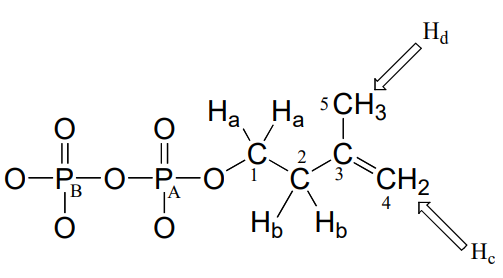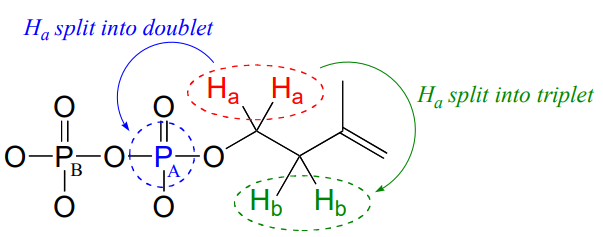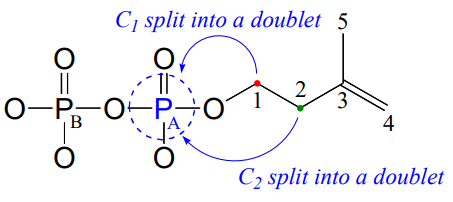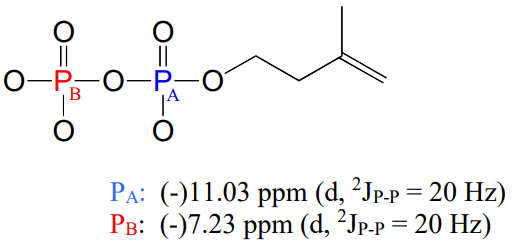9.10: NMR of phosphorylated compounds
- Page ID
- 106567
\( \newcommand{\vecs}[1]{\overset { \scriptstyle \rightharpoonup} {\mathbf{#1}} } \)
\( \newcommand{\vecd}[1]{\overset{-\!-\!\rightharpoonup}{\vphantom{a}\smash {#1}}} \)
\( \newcommand{\id}{\mathrm{id}}\) \( \newcommand{\Span}{\mathrm{span}}\)
( \newcommand{\kernel}{\mathrm{null}\,}\) \( \newcommand{\range}{\mathrm{range}\,}\)
\( \newcommand{\RealPart}{\mathrm{Re}}\) \( \newcommand{\ImaginaryPart}{\mathrm{Im}}\)
\( \newcommand{\Argument}{\mathrm{Arg}}\) \( \newcommand{\norm}[1]{\| #1 \|}\)
\( \newcommand{\inner}[2]{\langle #1, #2 \rangle}\)
\( \newcommand{\Span}{\mathrm{span}}\)
\( \newcommand{\id}{\mathrm{id}}\)
\( \newcommand{\Span}{\mathrm{span}}\)
\( \newcommand{\kernel}{\mathrm{null}\,}\)
\( \newcommand{\range}{\mathrm{range}\,}\)
\( \newcommand{\RealPart}{\mathrm{Re}}\)
\( \newcommand{\ImaginaryPart}{\mathrm{Im}}\)
\( \newcommand{\Argument}{\mathrm{Arg}}\)
\( \newcommand{\norm}[1]{\| #1 \|}\)
\( \newcommand{\inner}[2]{\langle #1, #2 \rangle}\)
\( \newcommand{\Span}{\mathrm{span}}\) \( \newcommand{\AA}{\unicode[.8,0]{x212B}}\)
\( \newcommand{\vectorA}[1]{\vec{#1}} % arrow\)
\( \newcommand{\vectorAt}[1]{\vec{\text{#1}}} % arrow\)
\( \newcommand{\vectorB}[1]{\overset { \scriptstyle \rightharpoonup} {\mathbf{#1}} } \)
\( \newcommand{\vectorC}[1]{\textbf{#1}} \)
\( \newcommand{\vectorD}[1]{\overrightarrow{#1}} \)
\( \newcommand{\vectorDt}[1]{\overrightarrow{\text{#1}}} \)
\( \newcommand{\vectE}[1]{\overset{-\!-\!\rightharpoonup}{\vphantom{a}\smash{\mathbf {#1}}}} \)
\( \newcommand{\vecs}[1]{\overset { \scriptstyle \rightharpoonup} {\mathbf{#1}} } \)
\( \newcommand{\vecd}[1]{\overset{-\!-\!\rightharpoonup}{\vphantom{a}\smash {#1}}} \)
\(\newcommand{\avec}{\mathbf a}\) \(\newcommand{\bvec}{\mathbf b}\) \(\newcommand{\cvec}{\mathbf c}\) \(\newcommand{\dvec}{\mathbf d}\) \(\newcommand{\dtil}{\widetilde{\mathbf d}}\) \(\newcommand{\evec}{\mathbf e}\) \(\newcommand{\fvec}{\mathbf f}\) \(\newcommand{\nvec}{\mathbf n}\) \(\newcommand{\pvec}{\mathbf p}\) \(\newcommand{\qvec}{\mathbf q}\) \(\newcommand{\svec}{\mathbf s}\) \(\newcommand{\tvec}{\mathbf t}\) \(\newcommand{\uvec}{\mathbf u}\) \(\newcommand{\vvec}{\mathbf v}\) \(\newcommand{\wvec}{\mathbf w}\) \(\newcommand{\xvec}{\mathbf x}\) \(\newcommand{\yvec}{\mathbf y}\) \(\newcommand{\zvec}{\mathbf z}\) \(\newcommand{\rvec}{\mathbf r}\) \(\newcommand{\mvec}{\mathbf m}\) \(\newcommand{\zerovec}{\mathbf 0}\) \(\newcommand{\onevec}{\mathbf 1}\) \(\newcommand{\real}{\mathbb R}\) \(\newcommand{\twovec}[2]{\left[\begin{array}{r}#1 \\ #2 \end{array}\right]}\) \(\newcommand{\ctwovec}[2]{\left[\begin{array}{c}#1 \\ #2 \end{array}\right]}\) \(\newcommand{\threevec}[3]{\left[\begin{array}{r}#1 \\ #2 \\ #3 \end{array}\right]}\) \(\newcommand{\cthreevec}[3]{\left[\begin{array}{c}#1 \\ #2 \\ #3 \end{array}\right]}\) \(\newcommand{\fourvec}[4]{\left[\begin{array}{r}#1 \\ #2 \\ #3 \\ #4 \end{array}\right]}\) \(\newcommand{\cfourvec}[4]{\left[\begin{array}{c}#1 \\ #2 \\ #3 \\ #4 \end{array}\right]}\) \(\newcommand{\fivevec}[5]{\left[\begin{array}{r}#1 \\ #2 \\ #3 \\ #4 \\ #5 \\ \end{array}\right]}\) \(\newcommand{\cfivevec}[5]{\left[\begin{array}{c}#1 \\ #2 \\ #3 \\ #4 \\ #5 \\ \end{array}\right]}\) \(\newcommand{\mattwo}[4]{\left[\begin{array}{rr}#1 \amp #2 \\ #3 \amp #4 \\ \end{array}\right]}\) \(\newcommand{\laspan}[1]{\text{Span}\{#1\}}\) \(\newcommand{\bcal}{\cal B}\) \(\newcommand{\ccal}{\cal C}\) \(\newcommand{\scal}{\cal S}\) \(\newcommand{\wcal}{\cal W}\) \(\newcommand{\ecal}{\cal E}\) \(\newcommand{\coords}[2]{\left\{#1\right\}_{#2}}\) \(\newcommand{\gray}[1]{\color{gray}{#1}}\) \(\newcommand{\lgray}[1]{\color{lightgray}{#1}}\) \(\newcommand{\rank}{\operatorname{rank}}\) \(\newcommand{\row}{\text{Row}}\) \(\newcommand{\col}{\text{Col}}\) \(\renewcommand{\row}{\text{Row}}\) \(\newcommand{\nul}{\text{Nul}}\) \(\newcommand{\var}{\text{Var}}\) \(\newcommand{\corr}{\text{corr}}\) \(\newcommand{\len}[1]{\left|#1\right|}\) \(\newcommand{\bbar}{\overline{\bvec}}\) \(\newcommand{\bhat}{\widehat{\bvec}}\) \(\newcommand{\bperp}{\bvec^\perp}\) \(\newcommand{\xhat}{\widehat{\xvec}}\) \(\newcommand{\vhat}{\widehat{\vvec}}\) \(\newcommand{\uhat}{\widehat{\uvec}}\) \(\newcommand{\what}{\widehat{\wvec}}\) \(\newcommand{\Sighat}{\widehat{\Sigma}}\) \(\newcommand{\lt}{<}\) \(\newcommand{\gt}{>}\) \(\newcommand{\amp}{&}\) \(\definecolor{fillinmathshade}{gray}{0.9}\)Because so many biological molecules contain phosphoryl groups, it is worthwhile to look at how scientists use NMR to determine the structure of these molecules. Recall from section 5.1 that \(^{31}P\), the most abundant isotope of phosphorus, is \(NMR\) active: it can be directly observed by \(^{31}P-NMR\), and indirectly observed in \(^1H-NMR\) and \(^{13}C-NMR\) through its spin-coupling interactions with neighboring protons and carbons, respectively.
Consider the case of isopentenyl diphosphate, the building block molecule used by cells to make 'isoprenoid' compounds such as cholesterol (in many animals), or \(\beta \)-carotene (in some plants). \(NMR\) spectra of this molecule were taken in a \(D_2O\) solvent, buffered with \(ND_4OD\) (the deuterium equivalent of aqueous ammonium hydroxide, \(NH_4OH\)) (J. Org. Chem. 1986, 51, 4768). In our discussion, carbon atoms are specified with numbers, protons with lower case letters, and phosphorus atoms with upper case letters.

First, let's look at the proton spectrum:
\(^1H-NMR\)
\(H_a: 4.05 ppm (t_d); ^3J_{H_a-H_b} = 6.6\) Hz; \(^3J_{H_a-P_A} = 3.3\) Hz.
\(H_b: 2.39 ppm (t) ^3J_{H_a-H_b} = 6.6\) Hz
\(H_c: 4.86 ppm (s)\)
\(H_d: 1.77 ppm (s)\)

The signals for \(H_b\), \(H_c\), and \(H_d\) look like we would expect from our discussion in chapter 5, with the exception of Hc which you will be invited to discuss in the exercise below. Why, though, is the signal for Ha split into a triplet of doublets (td)? First of all, as, expected, the two neighboring Hb protons split the Ha signal into a triplet, with 3JH-H = 6.6 Hz. Then, the signal is further split into doublets (\(^3J_{H-P} = 3.3\) Hz) by \(P_A\), the closer of the two phosphorus atoms. A phosphorus atom will
The signal for the two '\(H_c\)' protons in isopentenyl diphosphate is reported above as a singlet integrating to \(2H\). Are these two protons really chemically equivalent, and, according to what you know about proton \(NMR\), should this signal really be a singlet? If not, what kind of signal(s) would you expect to see? Explain any discrepancies between what you would expect to see and the actual reported data.
Now, let's look at the \(^{13}C\) spectrum of IPP:
\(^{13}C-NMR\) (proton-decoupled)
\(C_1: 40.7 ppm (d); ^2J_{C_1-P_A} = 7.2\) Hz
\(C_2: 67.0 ppm (d); ^3J_{C_2-P_A} = 4.0\) Hz
\(C_3: 147.4 ppm\)
\(C_4: 114.6 ppm\)
\(C_5: 24.5 ppm\)

Notice that the signals for both \(C_1\) and \(C_2\) are split into doublets by the magnetic field of \(P_A\). Phosphorus atoms will spin-couple with \(^{13}C\) nuclei up to three bonds away. Notice also that the 2-bond coupling between \(C_1\) and \(P_A\) is larger than the 3-bond coupling between \(C_2\) and \(P_A\) (7.2 Hz vs. 4.0 Hz). Finally, notice that we do not observe 4-bond \(C-P\) coupling: \(C_3\) is not spin-coupled to \(P_A\), and \(P_B\) is not coupled to any of the \(^{13}C\) or \(^1H\) nuclei on the molecule.
Remember that when processing a typical \(^{13}C-NMR\) spectrum, we electronically 'turn off' spin coupling between carbons and neighboring protons in order to simplify the spectrum (this is referred to as 'proton decoupling'). Proton decoupling does not turn off \(C-P\) spin coupling.
Because \(^{31}P\) is \(NMR\)-active, we can also, with an \(NMR\) spectrophotometer equipped with a phosphorus probe, directly observe the phosphorus \(NMR\) signals, just as we can directly observe the signals from protons and \(^{13}C\) nuclei. On an NMR instrument where protons resonate at 300 MHz and \(^{13}C\) nuclei resonate at 75 MHz, phosphorus resonates at 32 MHz. In \(^{31}P-NMR\) experiments, the reference standard used to determine the 0 ppm point is usually phosphoric acid (tetramethylsilane, the standard 0 ppm point for \(^1H\)- and \(^{13}C-NMR\), doesn't have a phosphorus atom!). The \(^{31}P-NMR\) spectrum of isopentenyl diphosphate has, as expected, two peaks, each of which is upfield of the phosphoric acid standard (negative chemical shifts!) and split into a doublet (\(^2J_{P-P} = 20\) Hz) due to 2-bond coupling between the two phosphorus nuclei.

Notice that although the \(C_1\) and \(C_2\) signals were split by \(P_A\) in our \(^{13}C-NMR\) spectrum, in the \(^{31}P-NMR\) spectrum the converse is not true: the \(P_A\) signal is not split by \(C_1\) or \(C_2\). Both of these carbons are \(NMR\)-inactive \(^{12}C\) isotope in 99 out of 100 molecules. In addition, \(P-H\) splitting is not observed in this \(^{31}P\) spectrum, because proton decoupling is in effect.


